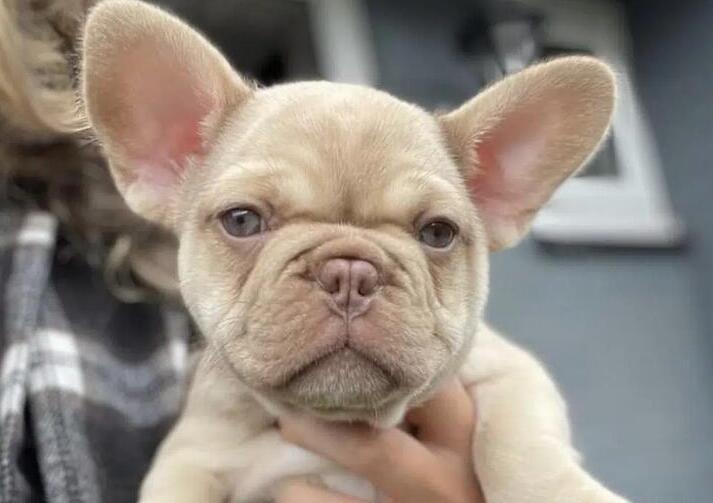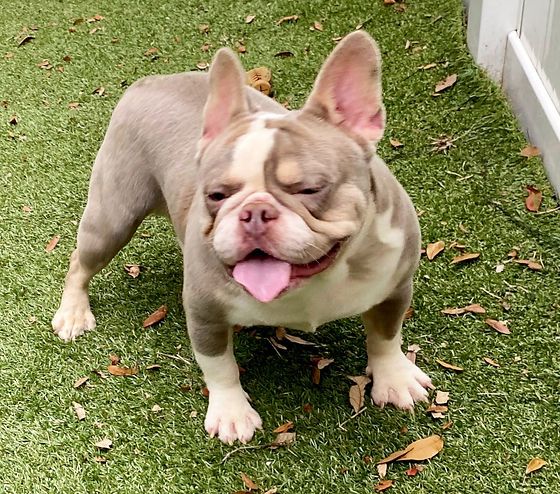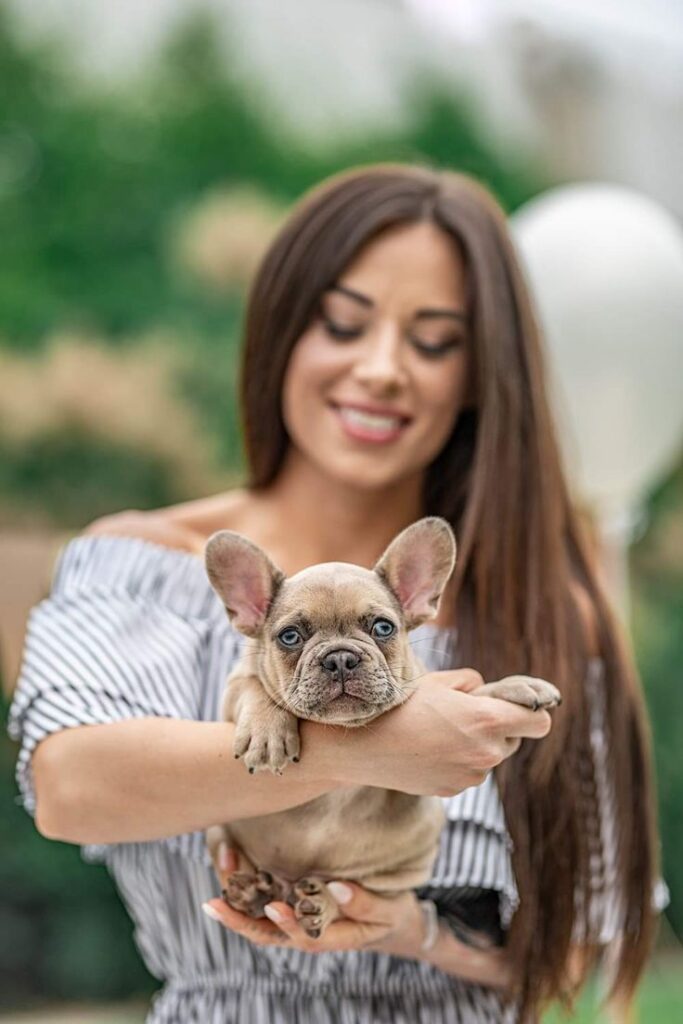Meet the Isabella French Bulldog, one of the cutest things you’ll ever see today.
Read this article to know everything about the Isabella French Bulldog.
Related: 20 Most Hilarious Dog Side-Eye Memes to Make You Laugh All Day
History of Isabella French Bulldogs

The Isabella French Bulldog, a captivating breed with its enchanting fawn-coloured coat, has a rich history that traces back to the origins of the French Bulldog breed. To understand the Isabella variety, we must first delve into the beginnings of this beloved canine companion.
In the early 1800s, they started as mini bulldogs in England. During the Industrial Revolution, French-bound lace workers took these cuties with them. France fell in love with their adorable looks and sweet personalities.
The working class and artists especially adored these furry pals. And voila! The French Bulldog was born and became a global sensation.
Among the various coat colour variations of French Bulldogs, the Isabella variety stands out with its unique and mesmerizing fawn-coloured coat. It rocks a mesmerising fawn-coloured coat that’s truly one of a kind.
The secret sauce? A special genetic combo involving the double dilute (dd) gene. This gene does its magic, diluting the usual black coat and creating that stunning Isabella look.
The Isabella French Bulldog is no ordinary pup – it’s got history! Even though it’s a newer colour compared to others, it’s made a splash. People worldwide are falling for its rare and distinctive charm. It’s not just a pet; it’s a symbol of uniqueness and refinement. The Isabella Frenchie is writing its own chapter in the breed’s fascinating tale.
Related: Tips on how to know your pregnant dog is in labour
What Is an Isabella French Bulldog?

An Isabella Frenchie — also known by some as a Lilac Frenchie — is an unofficial French Bulldog colour.
This means that it is not officially recognized by major kennel clubs such as the American Kennel Club (AKC) according to their French Bulldog Breed Standard.
The Dilution Gene
The pale colour of the Isabella Frenchie comes from a gene that is known as the dilution gene.
The Isabella colour appears when a dog with a Liver (brown) coat also has the dilution gene.
It’s the same gene responsible for the Bluecoat, but the Blue colour happens when a Black dog has the dilution gene.
Things to know about the Isabella colour
- It can vary— its shade can vary from lighter to darker
- It’s unofficial— Isabella is not part of the AKC’s French Bulldog Breed Standard
- It can fade over time— As dogs get older, the shade can fade
- It can cause health issues— The dilution gene responsible for their coat can cause some health problems
- It’s similar to the Blue colour— it may be similar, but it’s not the same as “Blue,“
- It’s seen in many other breeds— for example, Poodles, Bichon Frises, and Cocker Spaniels.
- Its genetics are even rarer than Blue— both the liver & dilution genes are recessive, whereas the genes for a black coat are dominant
Related: Can Dogs Have Honey? Important Facts to Know
Health and Lifespan of Isabella French Bulldogs

Colour Dilution Alopecia
Unfortunately, Isabella Frenchies, particularly, are prone to a condition called colour dilution alopecia, commonly abbreviated as CDA.
Color dilution alopecia is a hereditary skin disease that causes dry skin, flaky & itchy skin, and hair thinning & loss.
Colour Dilution Alopecia at a Glance
- Diagnosis involves ruling out other issues
- Age of onset is between 6 months to 2-3 years of age
- A genetic condition— more common in Blue/Lilac/Isabella/Blue Fawn dogs
- No cure— but it can be managed with moisturisers, dietary changes, vitamin supplementation, etc.
Symptoms of Color Dilution Alopecia
- Thin hair
- A dry & dull coat
- Hyperpigmentation
- Hair loss that progressively gets worse— it starts out as patches of hair loss.
Colour Dilution Alopecia cannot be tested for
Unfortunately, it is not currently possible to test for colour dilution alopecia as the gene directly responsible is still unknown.
How Long Does The Isabella French Bulldog Live?
Isabella French Bulldogs typically enjoy a lifespan of 10 to 12 years. Attentive care, a balanced diet, and regular exercise pave the way for a longer and happier journey together.
Related: Dog Nanny for hire! Rich American family offers whooping sum for lucky candidate
Regular Frenchie Health Issues
French Bulldogs in general (not just Lilac, Isabellas, or Merles) are prone to a whole bunch of health issues…
Among Frenchies’ many health issues, joint problems are the most common.
1. Allergies: French Bulldogs can develop allergies to environmental factors such as pollen, dust, and certain types of food. Common symptoms of allergies in dogs include itching, skin irritation, and digestive issues.
2. Breathing issues: Due to their short snouts and flat faces, French Bulldogs can experience breathing problems. Stenotic nares (narrowed nostrils), elongated soft palate (a condition where the soft palate obstructs the airway), and tracheal collapse (when the trachea collapses or flattens) are all common respiratory problems in Frenchies.
3. Joint problems: Joint problems are among the most common health issues in French Bulldogs. Hip dysplasia, elbow dysplasia, patellar luxation (knee joint dislocation), and arthritis are all conditions that can affect Frenchies and cause pain and mobility issues.
4. Spinal issues: French Bulldogs can also be prone to spinal problems such as hemivertebrae (a spinal deformity), intervertebral disc disease (a condition where the discs between the vertebrae in the spine degenerate or rupture), and degenerative myelopathy (a progressive disease that affects the spinal cord).
5. Eye problems: Cherry eye (a condition where the tear gland in the eye protrudes from its normal position), cataracts (cloudiness in the lens of the eye), entropion (a condition where the eyelid rolls inward), and distichiasis (an abnormal eyelash growing from the wrong location) are all eye problems that can affect Frenchies.
Related: Merle French Bulldog: All you Need to Know
Caring for an Isabella French Bulldog

Dietary Needs
Delight your Isabella French Bulldog’s taste buds with a nourishing, well-balanced diet tailored to support their unique coat.
Collaborate with your vet to discover the perfect culinary delights for your furry friend.
Exercise Requirements
While Isabella French Bulldogs are content with moderate activity, they thrive on engaging walks, playful sessions, and interactive toys.
These shared adventures strengthen your bond and keep both body and spirit vibrant.
Does The French Bulldog Get Along With Kids Or Animals?

French Bulldogs are often known as fantastic companions for families, thanks to their gentle and playful nature. Here’s a closer look at their interactions with kids and other animals:
French Bulldogs and Kids
Frenchies are typically gentle and love to play, making them great playmates for kids. Their smaller size also makes them less intimidating for younger children.
Like with any dog, it’s crucial to supervise interactions between French Bulldogs and children to ensure everyone’s safety. Teaching kids to treat their dogs kindly and never leave them alone together is a good practice.
Early socialization is essential for all dogs, and French Bulldogs are no exception. Introducing your Frenchie to children from a young age helps them learn how to interact appropriately and builds positive associations.
French Bulldog and Animals
While the French bulldog does get along with other animals, it is very important to watch out for the prey drive.
Related: How Often Should you Take your Cat to the Veterinarian?
How to Train Your Isabella French Bulldog
Before we share our French bulldog training tips, it is important you make a training schedule or plan.
Your schedule should include what you want to teach and when you will be training.
As well as training, socialisation is a critical part of any puppy’s development. Blending socialization into your training schedule is a great way to expose your dog to other people, places and sounds.
You can use the training plan below as a guide:
| Trigger | Symptoms |
|---|---|
| Is your dog mentally satisfied? | If your dog isn’t being mentally stimulated, then boredom will set in. Dogs that have daily playtime and training time display far fewer behavioural problems. Training gives a dog something to think about… other than eating soil by occupying their brain power! Chew toys are also a great aid during training and games. |
| Is your dog exercised daily? | If your dog isn’t getting suitable physical exercise, they will be prone to stress. Exercising your dog allows them to release their energy and is scientifically proven to relax your dog. |
| Is your dog starved of attention? | Dogs which are left home alone for longer periods of time (over 3 hours/day) require attention. An easy solution is to bring in a professional dog walker or find a suitable daycare centre. |
| Is your dog getting the correct vitamins? | If your dog’s diet isn’t nutritionally complete, this can cause behavioural issues. American Journal of Veterinary Research published a study showing dogs deficient in Vitamin B1 develop coprophagia. |
French Bulldog Puppy Housebreaking
Potty training a French Bulldog is something that you should start as soon as your puppy comes home.
The fewer accidents your puppy has inside, the faster he will be housetrained!
Just like how you should have a training schedule, you should have a daily potty schedule to housebreak a French Bulldog successfully.
Try to remember to take your puppy out:
- After waking from a nap.
- After playing.
- After eating.
- Every hour.
You will need to do this consistently for two to six weeks for your dog to be housebroken.
If your puppy does have an accident, simply clean it up.
Make sure you clean the area thoroughly using biological washing powder mixed with water.
It is important to avoid punishing your puppy. This will make your puppy worried or anxious around you, and is the opposite of how you want your puppy to see you!
Teach A French Bulldog Puppy To Sit
Sit is usually the first obedience trick people start with when training French Bulldogs.
This is because it is very important to teach a nice behaviour for your puppy to know so that they can ‘ask’ politely for many different things and offer behaviours which have some self-control:
- Sitting for mealtimes.
- Sitting for the door to be opened.
- Sitting to have a leash put on.
Sit is less important than the other key obedience skills (e.g. stay), but it is a fundamental skill necessary for more advanced tricks (e.g. settle).
Related: Top 15 Smart Animals in the World You Should Know
How to Teach Your French Bulldogs To Sit
- Start with a small piece of food clasped in your hand.
- Show your puppy the food but don’t allow them to eat the treat.
- Slowly move your hand back over their head so that they lift their head backwards to follow the treat.
- At some point, they’ll probably pop their bottom on the floor- at which point, say ‘good puppy!” and release the food treat.
- Repeat several times until smooth.
- Now you can add your cue word: Say your word ‘sit’ once, and then repeat what you’ve been doing so far.
- Your puppy will come to learn that sit = sit my bottom down!
Training French Bulldogs To Stay
Sitting still for any puppy is very tricky because there are so many more exciting things to do.
To build up a long stay and how far away you are separated, you must start gradually and use lots of rewards regularly.
Frenchies are usually quite inclined to follow people’s every movement, so staying training can be tricky!
How to Teach Your French Bulldogs to Stay Still
- Start by asking your puppy to sit.
- Then raise your hand (as if it were a stop sign- a flat palm!), and say ‘stay’.
- Make a slight rocking motion backward as if you were about to take a step back.
- If your puppy stays, go back and reward them!
- Repeat this a few times.
- Now take a full step backward. Pause. Reward.
- Gradually build up how far away you can get from your puppy over several weeks.
Related: What is a Mini Cow? Care Tips, Price, How to Get a Mini Cow
Conclusion
The Isabella French Bulldog is a unique and captivating breed. It’s an offshoot of the traditional French Bulldog, cherished for its rare fawn-coloured coat. This distinctive look is a result of a specific genetic trait, setting it apart in the world of canine breeds.
These dogs are not just visually striking but also carry a rich heritage, mirroring the evolution of the French Bulldog. The Isabella variety, though unofficial in terms of breed standards, has garnered a special place among dog lovers for its rare beauty and endearing qualities.
It’s a breed that represents both a rich history and a unique aesthetic appeal, making it a highly sought-after companion for those who appreciate its rarity and charm.
If there are any questions, post them below.
Related: Polish Chicken: Everything you Need to Know
FAQs for Isabella French Bulldog
What is an Isabella French bulldog?
An Isabella Frenchie — also known by some as a Lilac Frenchie — is an unofficial French Bulldog colour.
This means that it is not officially recognised by major kennel clubs such as the American Kennel Club (AKC) according to their French Bulldog Breed Standard.
How much do Isabella French bulldogs cost?
5 million naira. (6500 USD)
Why are Isabella Frenchies so expensive?
The cost of Isabella French Bulldogs can vary significantly depending on several factors, including:
Breeder Reputation: Reputable breeders who prioritize health testing, ethical breeding practices, and proper socialization will typically charge more than backyard breeders or puppy mills.
Lineage and Pedigree: Puppies from champion bloodlines or with impressive pedigrees can command higher prices.
Location: Prices can vary depending on the region and cost of living. Generally, expect to pay more in densely populated areas or major cities.
Gender: Female Isabella French Bulldogs typically cost more than males.
Coat Colour and Markings: Isabella is one of the rarest and most sought-after French Bulldog colours, so expect to pay a premium for it. The presence of additional markings like brindle or merle can further increase the price.
Age: Puppies generally cost more than adult dogs. However, older puppies with desirable qualities may still command a higher price.
What’s the most expensive dog?
The title of the most expensive dog in the world goes to a red Tibetan Mastiff named Big Splash, who was sold for a whopping $1.5 million in 2014! Tibetan Mastiffs are known for their massive size, lion-like appearance, and regal demeanour, making them highly sought-after status symbols in some parts of the world, particularly China.
What’s the most expensive Frenchie colour?
The Isabella’s unique lilac coat, a result of a dilute chocolate gene, sets it apart from its fawn or brindle counterparts. This rarity, coupled with the Frenchie’s growing popularity, drives up the price tag significantly.
